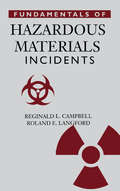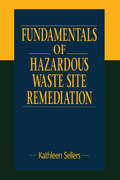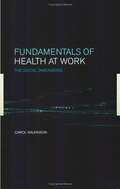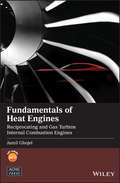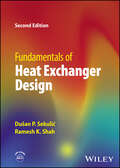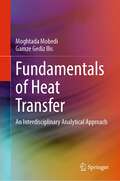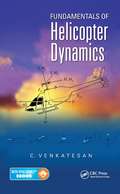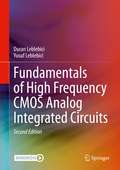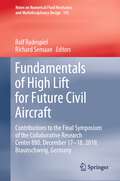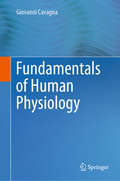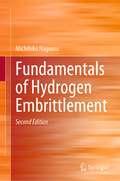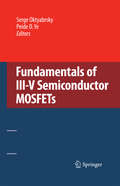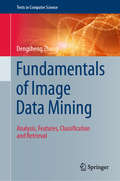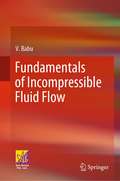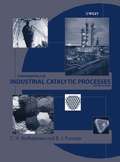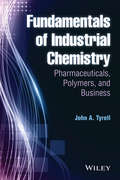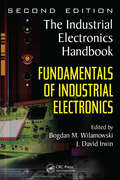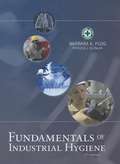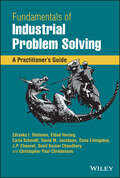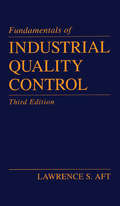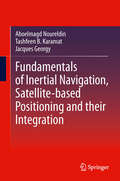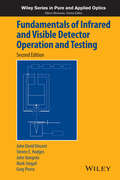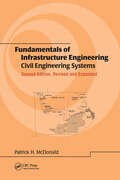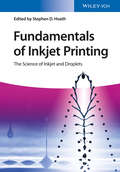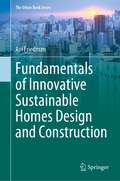- Table View
- List View
Fundamentals of Hazardous Materials Incidents
by Reginald Campbell R. Everett LangfordThis book evolved from the course developed at the U.S. Department of Labor's National Mine, Health, and Safety Academy to develop the legislation that eventually became 29 CFR 1910.120.Fundamentals of Hazardous Materials Incidents offers the reader a basic understanding of the principles involved in toxicology, federal regulations, respiratory protection, personal protective equipment, radiation, environmental considerations, industrial hygiene sampling, site safety, and chemically resistant suits. Thousands of people have been trained using this manual, now revised and available for the first time in hardcover format. The book is essential for identifying potential problems at hazardous waste sites, covers diverse topics throughout the area of hazardous materials response, and is ideal for training courses to meet 29 CFR 1910.120 requirements. Quantity discounts available.
Fundamentals of Hazardous Waste Site Remediation
by Kathleen SellersEvery practicing environmental engineer should already have a firm grasp on the basics of hazardous waste site remediation-the key to confronting a site problem, and devising an effective solution.Since their original introduction to remediation, technology has kept moving ahead with new ideas and procedures. Fundamentals of Hazardous Waste Site Remediation gives environmental professionals immediate access to the basics of the trade, along with information about recent advancements.This comprehensive overview examines the basics of such areas as hazardous materials chemistry, hydrogeology, reaction engineering, and clean-up level development. A chapter on Cost Estimating will be of particular interest to specialists, in light of recent concerns about the increased costs of remediation. After reading each chapter, test your new knowledge with the review problems.As a refresher guide for career environmental engineers, or a helpful tool to newcomers in the field, Fundamentals of Hazardous Waste Site Remediation is a valuable resource for longtime professionals and newcomers alike.
Fundamentals of Health at Work
by C. WilkinsonFundamentals of Health at Work is an engaging re-assessment of workplace health, with particular emphasis on the neglected issues of the social context of the working environment and the impact on individuals of their workplaces. In looking at the historical context of the subject and at the concepts of health and illness, a selective series of tho
Fundamentals of Heat Engines: Reciprocating and Gas Turbine Internal Combustion Engines (Wiley-ASME Press Series)
by Jamil GhojelSummarizes the analysis and design of today’s gas heat engine cycles This book offers readers comprehensive coverage of heat engine cycles. From ideal (theoretical) cycles to practical cycles and real cycles, it gradually increases in degree of complexity so that newcomers can learn and advance at a logical pace, and so instructors can tailor their courses toward each class level. To facilitate the transition from one type of cycle to another, it offers readers additional material covering fundamental engineering science principles in mechanics, fluid mechanics, thermodynamics, and thermochemistry. Fundamentals of Heat Engines: Reciprocating and Gas Turbine Internal-Combustion Engines begins with a review of some fundamental principles of engineering science, before covering a wide range of topics on thermochemistry. It next discusses theoretical aspects of the reciprocating piston engine, starting with simple air-standard cycles, followed by theoretical cycles of forced induction engines, and ending with more realistic cycles that can be used to predict engine performance as a first approximation. Lastly, the book looks at gas turbines and covers cycles with gradually increasing complexity to end with realistic engine design-point and off-design calculations methods. Covers two main heat engines in one single reference Teaches heat engine fundamentals as well as advanced topics Includes comprehensive thermodynamic and thermochemistry data Offers customizable content to suit beginner or advanced undergraduate courses and entry-level postgraduate studies in automotive, mechanical, and aerospace degrees Provides representative problems at the end of most chapters, along with a detailed example of piston-engine design-point calculations Features case studies of design-point calculations of gas turbine engines in two chapters Fundamentals of Heat Engines can be adopted for mechanical, aerospace, and automotive engineering courses at different levels and will also benefit engineering professionals in those fields and beyond.
Fundamentals of Heat Exchanger Design
by Dusan P. Sekulic Ramesh K. ShahFundamentals of Heat Exchanger Design A cutting-edge update to the most essential single-volume resource on the market Heat exchangers are thermal devices which transfer heat between two or more fluids. They are integral to energy, automotive, aerospace, and myriad other technologies. The design and implementation of heat exchangers is an essential skill for engineers looking to contribute to a huge range of applications. Fundamentals of Heat Exchanger Design, Second Edition provides a comprehensive insight into the design and performance of heat exchangers. After introducing the basic heat transfer concepts and parameters, an overview of design methodologies is discussed. Subsequently, details of design theory of various types of exchangers are presented. The first edition established itself as the standard single-volume text on the subject. The second edition preserves an established in-depth approach but reflects some new technological developments related to design for manufacturing compact heat exchangers, including novel 3-D printing approaches to heat exchanger design. Readers of the second edition of Fundamentals of Heat Exchanger Design will also find: A new section on the design for manufacturing of compact heat exchangers A new section on design for additive manufacturing compact heat exchangers Detailed discussions of the design of recuperators and regenerators, pressure drop analysis, geometric parameters, heat transfer correlations, and more Fundamentals of Heat Exchanger Design is ideal for practicing engineers, as well as for advanced undergraduate and graduate students in mechanical and aerospace engineering, energy engineering, and related subjects.
Fundamentals of Heat Transfer: An Interdisciplinary Analytical Approach
by Moghtada Mobedi Gamze Gediz IlisThis book demonstrates the analytical solution of fundamental problems in heat transfer which covers conduction, convection, and radiation heat transfer. The analytical solution of heat transfer problems is described in a simple way which is easy to understand. This book also provides competence of solving fundamental heat transfer problems by analytical method which is particularly important to gain a strong background on heat transfer. The book is an interdisciplinary heat transfer book which is useful for all academicians and students from different disciplines with different levels of mathematical knowledge. The book can be used as a core or supplementary textbook in undergraduate and graduate bridge courses. Furthermore, it is suitable for professional and vocational coursework for technology and engineering professionals.
Fundamentals of Helicopter Dynamics
by C. VenkatesanHelicopter Dynamics Introduced in an Organized and Systematic MannerA result of lecture notes for a graduate-level introductory course as well as the culmination of a series of lectures given to designers, engineers, operators, users, and researchers, Fundamentals of Helicopter Dynamics provides a fundamental understanding and a thorough overview o
Fundamentals of High Frequency CMOS Analog Integrated Circuits
by Yusuf Leblebici Duran LeblebiciThis textbook is ideal for senior undergraduate and graduate courses in RF CMOS circuits, RF circuit design, and high-frequency analog circuit design. It is aimed at electronics engineering students and IC design engineers in the field, wishing to gain a deeper understanding of circuit fundamentals, and to go beyond the widely-used automated design procedures. The authors employ a design-centric approach, in order to bridge the gap between fundamental analog electronic circuits textbooks and more advanced RF IC design texts. The structure and operation of the building blocks of high-frequency ICs are introduced in a systematic manner, with an emphasis on transistor-level operation, the influence of device characteristics and parasitic effects, and input–output behavior in the time and frequency domains. This second edition has been revised extensively, to expand some of the key topics, to clarify the explanations, and to provide extensive design examples and problems. New material has been added for basic coverage of core topics, such as wide-band LNAs, noise feedback concept and noise cancellation, inductive-compensated band widening techniques for flat-gain or flat-delay characteristics, and basic communication system concepts that exploit the convergence and co-existence of Analog and Digital building blocks in RF systems. A new chapter (Chapter 5) has been added on Noise and Linearity, addressing key topics in a comprehensive manner. All of the other chapters have also been revised and largely re-written, with the addition of numerous, solved design examples and exercise problems.
Fundamentals of High Lift for Future Civil Aircraft: Contributions to the Final Symposium of the Collaborative Research Center 880, December 17-18, 2019, Braunschweig, Germany (Notes on Numerical Fluid Mechanics and Multidisciplinary Design #145)
by Rolf Radespiel Richard SemaanThis book reports on the latest numerical and experimental findings in the field of high-lift technologies. It covers interdisciplinary research subjects relating to scientific computing, aerodynamics, aeroacoustics, material sciences, aircraft structures, and flight mechanics. The respective chapters are based on papers presented at the Final Symposium of the Collaborative Research Center (CRC) 880, which was held on December 17-18, 2019 in Braunschweig, Germany. The conference and the research presented here were partly supported by the CRC 880 on “Fundamentals of High Lift for Future Civil Aircraft,” funded by the DFG (German Research Foundation). The papers offer timely insights into high-lift technologies for short take-off and landing aircraft, with a special focus on aeroacoustics, efficient high-lift, flight dynamics, and aircraft design.
Fundamentals of Human Physiology
by Giovanni CavagnaThis textbook explores the fundamental qualitative and quantitative aspects of human physiology. It approaches biological and physiological processes and phenomena from a quantitative perspective, revealing how physiological problems can be mathematically formulated starting from simple laws of physics. The book addresses a broad range of topics, including: the statics and dynamics of circulation; muscle and sarcomere force-length and force-velocity relations, together with their mechanisms and functional consequences; subdivisions and meaning of the heat produced by muscle; locomotion, statics and dynamics of respiration; diffusion of gases and acid base equilibrium; phonation; general functions of the kidney and of the different sections of the nephron; changes in clearance with a substance’s plasmatic concentration; pH regulation and the kidney; Donnan’s equilibrium and its consequences; and the Nernst equation. The book offers the ideal learning resource for students of human physiology courses in medicine and biomedicine, as well as biomedical engineering and biophysics graduate students. An elementary grasp of mathematics and physics is sufficient to understand the content.
Fundamentals of Hydrogen Embrittlement
by Michihiko NagumoThis book is the second edition of the one originally published in 2016, as the first comprehensive treatment on the fundamentals of hydrogen embrittlement of metallic materials, mainly steel. The book provides students and researchers engaging in hydrogen problems with a unified view of the subject. Establishing reliable principles for materials design against hydrogen embrittlement and assessing their performance are recent urgent industrial needs in developing high-strength steel for hydrogen energy equipment and weight-reducing vehicles. The interdisciplinary nature of the subject, covering metal physics, materials science, and mechanics of fracture, has disturbed a profound understanding of the problem. In this book, previous studies are critically reviewed, and supplemental descriptions of fundamental ideas are presented when necessary. Emphasis is placed on experimental facts, with particular attention to their implication rather than phenomenological appearance. The adopted experimental conditions are also noted since the operating mechanism of hydrogen might differ by material and environment. For theories, employed assumptions and premises are noted to examine their versatility. Progress in the past decade in experimental and theoretical tools is remarkable and has nearly unveiled characteristic features of hydrogen embrittlement. Proposed models have almost covered feasible aspects of the function of hydrogen. This second edition has enriched the contents with recent crucial findings. Chapters on the manifestation of embrittlement in the deterioration of mechanical properties and microscopic features are reorganized, and the description is revised for the convenience of readers’ systematic understanding. A new chapter is created for delayed fracture in atmospheric environments as a conclusive subject of critical ideas presented in this book.
Fundamentals of III-V Semiconductor MOSFETs
by Peide Ye Serge OktyabrskyFundamentals of III-V Semiconductor MOSFETs presents the fundamentals and current status of research of compound semiconductor metal-oxide-semiconductor field-effect transistors (MOSFETs) that are envisioned as a future replacement of silicon in digital circuits. The material covered begins with a review of specific properties of III-V semiconductors and available technologies making them attractive to MOSFET technology, such as band-engineered heterostructures, effect of strain, nanoscale control during epitaxial growth. Due to the lack of thermodynamically stable native oxides on III-V's (such as SiO2 on Si), high-k oxides are the natural choice of dielectrics for III-V MOSFETs. The key challenge of the III-V MOSFET technology is a high-quality, thermodynamically stable gate dielectric that passivates the interface states, similar to SiO2 on Si. Several chapters give a detailed description of materials science and electronic behavior of various dielectrics and related interfaces, as well as physics of fabricated devices and MOSFET fabrication technologies. Topics also include recent progress and understanding of various materials systems; specific issues for electrical measurement of gate stacks and FETs with low and wide bandgap channels and high interface trap density; possible paths of integration of different semiconductor materials on Si platform.
Fundamentals of Image Data Mining: Analysis, Features, Classification and Retrieval (Texts in Computer Science)
by Dengsheng ZhangThis reader-friendly textbook presents a comprehensive review of the essentials of image data mining, and the latest cutting-edge techniques used in the field. The coverage spans all aspects of image analysis and understanding, offering deep insights into areas of feature extraction, machine learning, and image retrieval. The theoretical coverage is supported by practical mathematical models and algorithms, utilizing data from real-world examples and experiments.Topics and features: describes the essential tools for image mining, covering Fourier transforms, Gabor filters, and contemporary wavelet transforms; reviews a varied range of state-of-the-art models, algorithms, and procedures for image mining; emphasizes how to deal with real image data for practical image mining; highlights how such features as color, texture, and shape can be mined or extracted from images for image representation; presents four powerful approaches for classifying image data, namely, Bayesian classification, Support Vector Machines, Neural Networks, and Decision Trees; discusses techniques for indexing, image ranking, and image presentation, along with image database visualization methods; provides self-test exercises with instructions or Matlab code, as well as review summaries at the end of each chapter.This easy-to-follow work illuminates how concepts from fundamental and advanced mathematics can be applied to solve a broad range of image data mining problems encountered by students and researchers of computer science. Students of mathematics and other scientific disciplines will also benefit from the applications and solutions described in the text, together with the hands-on exercises that enable the reader to gain first-hand experience of computing.
Fundamentals of Incompressible Fluid Flow
by V. BabuThis highly informative and carefully presented book offers a comprehensive overview of the fundamentals of incompressible fluid flow. The textbook focuses on foundational topics to more complex subjects such as the derivation of Navier-Stokes equations, perturbation solutions, inviscid outer and inner solutions, turbulent flows, etc. The author has included end-of-chapter problems and worked examples to augment learning and self-testing. This book will be a useful reference for students in the area of mechanical and aerospace engineering.
Fundamentals of Industrial Catalytic Processes
by Calvin H. Bartholomew Robert J. FarrautoCatalysis is central to the chemical industry, as it is directly or involved in the production of almost all useful chemical products. In this book the authors, present the definitive account of industrial catalytic processes. Throughout Fundamentals of Industrial Catalytic Processes the information is illustrated with many case studies and problems. This book is valuable to anyone wanting a clear account of industrial catalytic processes, but is particularly useful to industrial and academic chemists and engineers and graduate working on catalysis. This book also: Covers fundamentals of catalytic processes, including chemistry, catalyst preparation, properties and reaction engineering. Addresses heterogeneous catalytic processes employed by industry. Provides detailed data on existing catalysts and catalytic reactions, process design and chemical engineering. Covers catalysts used in fuel cells.
Fundamentals of Industrial Chemistry
by John A. TyrellThis book discusses the connectivity between major chemicals, showing how a chemical is made along with why and some of the business considerations. The book helps smooth a student's transition to industry and assists current professionals who need to understand the larger picture of industrial chemistry principles and practices. The book:Addresses a wide scope of content, emphasizing the business and polymer / pharmaceutical / agricultural aspects of industrial chemistryCovers patenting, experimental design, and systematic optimization of experimentsWritten by an author with extensive industrial experience but who is now a university professor, making him uniquely positioned to present this materialHas problems at the end of chapters and a separate solution manual available for adopting professorsPuts chemical industry topics in context and ties together many of the principles chemistry majors learn across more specific courses
Fundamentals of Industrial Electronics: The Industrial Electronics Handbook
by J. David Irwin Bogdan M. WilamowskiThe Industrial Electronics Handbook, Second Edition combines traditional and newer, more specialized knowledge that will help industrial electronics engineers develop practical solutions for the design and implementation of high-power applications. Embracing the broad technological scope of the field, this collection explores fundamental areas, including analog and digital circuits, electronics, electromagnetic machines, signal processing, and industrial control and communications systems. It also facilitates the use of intelligent systems—such as neural networks, fuzzy systems, and evolutionary methods—in terms of a hierarchical structure that makes factory control and supervision more efficient by addressing the needs of all production components. Enhancing its value, this fully updated collection presents research and global trends as published in the IEEE Transactions on Industrial Electronics Journal, one of the largest and most respected publications in the field. Fundamentals of Industrial Electronics covers the essential areas that form the basis for the field. This volume presents the basic knowledge that can be applied to the other sections of the handbook. Topics covered include: Circuits and signals Devices Digital circuits Digital and analog signal processing Electromagnetics Other volumes in the set: Power Electronics and Motor Drives Control and Mechatronics Industrial Communication Systems Intelligent Systems
Fundamentals of Industrial Hygiene
by Barbara Plog Patricia QuinlanThis edition of Fundamentals of Industrial Hygiene presents original new chapters on Particulate Matter (Chapter 8), Ionizing Radiation (Chapter 11), Personal Protective Equipment (Chapter 23), Environmental Health and Safety (Chapter 28), Government Regulations (Chapter 30), and International Developments in Occupational Safety and Health (Chapter 31). All other chapters have been extensively updated and revised. The primary purpose of this book is to provide a reference for those who have either an interest in or a direct responsibility for the recognition, evaluation, and control of occupational health hazards. Thus, it is intended to be of use to industrial hygienists, industrial hygiene students, physicians, nurses, safety personnel from labor and industry, labor organizations, public service groups, government agencies, and manufacturers. Others who may find this reference helpful include consultants, engineers, architects, lawyers, and allied professional personnel who work with those engaged in business, industry, and agriculture. It is hoped that this book will be of use to those responsible for planning and carrying out programs to minimize occupational health hazards.
Fundamentals of Industrial Problem Solving: A Practitioner's Guide
by Carla Schmidt David M. Jacobson Dana Livingston J.P. Chauvel Zdravko I. Stefanov Eldad Herceg Sunil Kumar Chaudhary Christopher Paul ChristensonTeaches Readers How to Apply a Structured Problem-Solving Methodology for Industrial Fields Based on Sound Scientific Principles As modern industrial processes have become increasingly complex, complicated multi-factor problems have emerged. These complex problems end up costing companies millions of dollars every day. Existing problem-solving techniques are only effective to a certain point. This book provides a solution to a myriad of industrial problems by using first principles and rigorous hypothesis testing. Key topics covered within the work include: How to use the latest research, advanced modeling, big data mining, analytical testing, and many other techniques to systematically create and test hypotheses surrounding why a process is malfunctioning How to use scenario development to frame a team’s understanding of why a process is malfunctioning How to approach today’s lack of experienced industrial workers, whose failure to approach problem solving from first fundamentals are causing myriad of inefficiencies in industry How to use multiple methodologies together with an emphasis on first principles and mechanistic math modeling as a basis to industrial problem solving Engineers of any discipline working in both research and development of manufacturing environments, along with professionals in any industrial discipline looking to reduce costs will be able to use this work to both understand and pragmatically solve the pressing issues we see in today’s industrial market.
Fundamentals of Industrial Quality Control
by Lawrence S. Aft"Quality" is the latest buzz word in business and industry-quality control, quality assurance, quality improvement, and quality systems. But what does quality mean to you? Fundamentals of Industrial Quality Control, Third Edition shows how the concept of "quality" can be validated with basic statistical methods.
Fundamentals of Inertial Navigation, Satellite-based Positioning and their Integration
by Jacques Georgy Tashfeen B. Karamat Aboelmagd NoureldinFundamentals of Inertial Navigation, Satellite-based Positioning and their Integration is an introduction to the field of Integrated Navigation Systems. It serves as an excellent reference for working engineers as well as textbook for beginners and students new to the area. The book is easy to read and understand with minimum background knowledge. The authors explain the derivations in great detail. The intermediate steps are thoroughly explained so that a beginner can easily follow the material. The book shows a step-by-step implementation of navigation algorithms and provides all the necessary details. It provides detailed illustrations for an easy comprehension. The book also demonstrates real field experiments and in-vehicle road test results with professional discussions and analysis. This work is unique in discussing the different INS/GPS integration schemes in an easy to understand and straightforward way. Those schemes include loosely vs tightly coupled, open loop vs closed loop, and many more.
Fundamentals of Infrared and Visible Detector Operation and Testing
by John Vampola Mark Stegall John David Vincent Greg Pierce Steve HodgesPresents a comprehensive introduction to the selection, operation, and testing of infrared devices, including a description of modern detector assemblies and their operation This book discusses how to use and test infrared and visible detectors. The book provides a convenient reference for those entering the field of IR detector design, test or use, those who work in the peripheral areas, and those who teach and train others in the field. Chapter 1 contains introductory material. Radiometry is covered in Chapter 2. The author examines Thermal detectors in Chapter 3; the "Classical" photon detectors - simple photoconductors and photovoltaics in Chapter 4; and "Modern Photon Detectors" in Chapter 5. Chapters 6 through 8 consider respectively individual elements and small arrays of elements the "readouts" (ROICs) used with large imaging arrays; and Electronics for FPA Operation and Testing. The Test Set and The Testing Process are analyzed in Chapters 9 and 10, with emphasis on uncertainty and trouble shooting. Chapters 11 through 15 discuss related skills, such as Uncertainty, Cryogenics, Vacuum, Optics, and the use of Fourier Transforms in the detector business. Some highlights of this new edition are that it Discusses radiometric nomenclature and calculations, detector mechanisms, the associated electronics, how these devices are tested, and real-life effects and problems Examines new tools in Infrared detector operations, specifically: selection and use of ROICs, electronics for FPA operation, operation of single element and very small FPAs, microbolometers, and multi-color FPAs Contains five chapters with frequently sought-after information on related subjects, such as uncertainty, optics, cryogenics, vacuum, and the use of Fourier mathematics for detector analyses Fundamentals of Infrared and Visible Detector Operation and Testing, Second Edition, provides the background and vocabulary necessary to help readers understand the selection, operation, and testing of modern infrared devices.
Fundamentals of Infrastructure Engineering: Civil Engineering Systems, Second Edition, (Civil and Environmental Engineering)
by Patrick H. McDonaldBased on the author's extensive experience, this book presents recent advances in systems theory and methodology for infrastructure engineering. It highlights modern approaches to the analysis, design, construction, implementation, management, and maintenance of large-scale infrastructure systems and projects, including transportation and water res
Fundamentals of Inkjet Printing
by Stephen D. HoathFrom droplet formation to final applications, this practical book presents the subject in a comprehensive and clear form, using only content derived from the latest published results. Starting at the very beginning, the topic of fluid mechanics is explained, allowing for a suitable regime for printing inks to subsequently be selected. There then follows a discussion on different print-head types and how to form droplets, covering the behavior of droplets in flight and upon impact with the substrate, as well as the droplet's wetting and drying behavior at the substrate. Commonly observed effects, such as the coffee ring effect, are included as well as printing in the third dimension. The book concludes with a look at what the future holds. As a unique feature, worked examples both at the practical and simulation level, as well as case studies and videos are included. As a result, students and engineers in R&D will come to fully understand the complete process of inkjet printing.
Fundamentals of Innovative Sustainable Homes Design and Construction (The Urban Book Series)
by Avi FriedmanThis book offers ideas and practices on contemporary design concepts and illustrates them with plans and photographs of outstanding examples. Current planning and design modes of dwellings and neighborhoods are facing challenges of philosophy and form. Past approaches no longer sustain new demands and require innovative thinking. The need for a new outlook is propelled by fundamental changes that touch upon environmental, economic and social aspects. The depletion of non-renewable natural resources and climate change are a few of the environmental challenges. Increasing costs of material, labor, land and infrastructure have posed economic challenges with affordability being paramount among them. Social challenges are also drawing the attention of designers, builders and homeowners. Walkable communities, aging in place and multigenerational living are some of the concepts considered. In addition, live-work environments have become part of the economic reality for those who wish to work from home—which has become possible through digital advances. The text would be of interest to scholars working in: architecture, urban planning, and construction.
